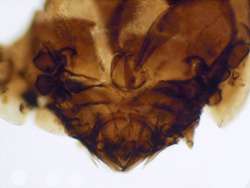Of mites, muck and the rise and fall of the Inca

Scientists have discovered a way to better explore the rise and fall of ancient empires such as the Inca - thanks to a tiny mite found preserved in the mud at the bottom of a sacred Peruvian lake.
Research by scientists in the UK, France and USA, published this month in the Journal of Archaeological Science, has identified a system of counting the number of fossilised mites found associated with animal excrement that could prove a valuable tool for archaeologists, epidemiologists, geologists, historians, geographers - and even global climate analysts looking at climatically sensitive areas of the world.
For now, the discovery offers a tantalising glimpse into the poorly-understood rise of the Inca empire, which was one of the most advanced of all ancient civilisations, yet which maintained no written record of its history, failed to invent the wheel and was all but wiped out by Spanish invaders in the first half of the 16th century.
Investigations by a team including paper authors and palaeoecologists Dr Michael Frogley (University of Sussex), Dr Alex Chepstow-Lusty (CNRS, Montpellier) and anthropologist Professor Brian Bauer (University of Illinois at Chicago) identified the fossil mites as a type found associated with areas of moist grassland and pasture suitable for grazing animals.
The mite remains were found in unusually high numbers in cored mud samples taken from the sacred lake of Maracocha, near Cuzco in highland Peru. The site was chosen because it sits at the centre of the ancient Inca empire and its transport network, which used lengthy caravans of llamas to ferry about the State's growing wealth - hence the rich source of hundreds of years' worth of animal droppings, on which the mites were able to feed.
Fluctuations in the numbers of fossil mites found in the lake muds are thought to correlate with the increases in the numbers of llamas present on the important trans-Andean trading routes that passed through Marcacocha while the Inca thrived - and with the plummeting numbers of native animals and people following the arrival of the Spanish. Mite numbers were shown to recover again during the late 16th and early 17th centuries with the introduction of familiar Old World domesticated animals, such as sheep, goats, horses and cattle, although this recovery was interrupted in the early 1700s as plague ravaged the region, decimating rural populations.
Spanish historical records corroborated the findings, so now the scientists plan to extend their research back into uncharted periods of pre-Incan history, where no other documentary records exist. Examining fossilised mite numbers may now also illuminate research into other environmentally sensitive areas of the world, where human activity is tied to environmental and ecological trends.
Dr Frogley says: "Until now, it has been very difficult to find a technique that can chart the changing patterns of trade or livestock across a landscape. This new mite methodology could have further, more wide-ranging applications for understanding all sorts of cultural ups and downs. Even the smallest and most mundane of animals, such as excrement-eating mites, can provide a window onto the calamitous impact that the Europeans had when they settled in the New World."
Citation: Chepstow-Lusty, A.C., Frogley, M.R., Bauer, B.S., Leng, M.J., Cundy, A.B., Boessenkool, K.P. & Gioda, A. (2007). Evaluating socio-economic change in the Andes using oribatid mite abundances as indicators of domestic animal densities. Journal of Archaeological Science 34 (7), 1178-1186.
Source: University of Sussex




















